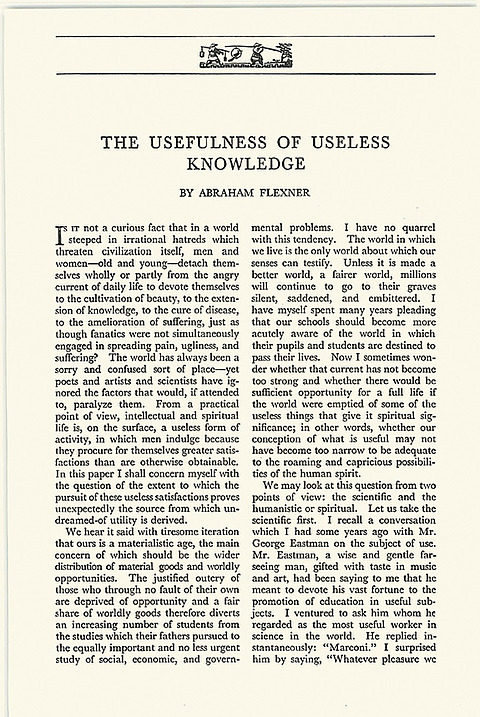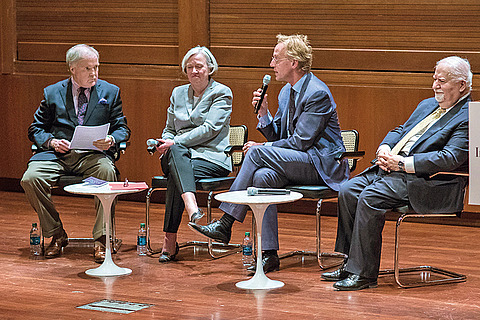The Usefulness of Useless Knowledge

Abraham Flexner’s perspective on the “usefulness of useless knowledge” has only gained in substance and breadth since his time. First and foremost, as Flexner argues so elegantly, basic research clearly advances knowledge in and of itself. Fundamental inquiry moves exploration as far up to the headwaters as possible, producing ideas that slowly and steadily turn into concrete applications and further studies. As it is often stated, knowledge is the only resource that increases when used.
Second, pathbreaking research leads to new tools and techniques, often in unpredictable and indirect ways. A remarkable, late-twentieth-century example of such a fortuitous outgrowth was the development of automatic information-sharing software, introduced as the World Wide Web in 1989. What began as a collaboration tool for thousands of particle physicists working at the CERN particle accelerator laboratory entered the public domain in 1993, unleashing the power of the Internet to the masses and facilitating large-scale communication around the globe. To store and process the vast amount of data produced in the same particle experiments, so-called grid and cloud computing were developed, linking computers in huge virtual networks around the world. These cloud technologies now drive many Internet business applications, from services and shopping to entertainment and social media.
A third attribute is the attraction of curiosity-driven research to the very best minds in the world. Young scientists and scholars, drawn to the intellectual challenges of fundamental questions, are trained in completely new ways of thinking and using technology. Once these skills carry over to society, they can have transformative effects. For example, scientists who have learned to capture complex natural phenomena in elegant mathematical equations apply these techniques to other branches of society and industry, such as in the quantitative analysis of financial and social data.

Fourth, much of the knowledge developed by basic research is made publicly accessible and so benefits society as a whole, spreading widely beyond the narrow circle of individuals who, over years and decades, introduce and develop the ideas. Fundamental advances in knowledge cannot be owned or restricted by people, institutions, or nations, certainly not in the current age of the Internet. They are truly public goods.
Finally, one of the most tangible effects of pathbreaking research appears in the form of start-up companies. The new industrial players of the past decades show how powerful technologies are in generating commercial activities. It is estimated that more than half of all economic growth comes from innovation. Leading information technology and biotech industries can trace their success directly to the fruits of fundamental research grown in the fertile environments around research universities such as in Silicon Valley and the Boston area, often infused by generous public investments. MIT estimates that it has given rise to more than thirty thousand companies with roughly 4.6 million employees, including giants such as Texas Instruments, McDonnell Douglas, and Genentech.
The two founders of Google worked as graduate students at Stanford University on a project supported by the Digital Libraries Initiative of the National Science Foundation—possibly the government grant with the highest payoff ever.
Flexner was not the first to argue for the power of curiosity and imagination. In “The Usefulness of Useless Knowledge,” he writes, “Curiosity, which may or may not eventuate in something useful, is probably the outstanding characteristic of modern thinking. It is not new. It goes back to Galileo, Bacon, and to Sir Isaac Newton, and it must be absolutely unhampered.”
While the big-picture arguments for blue-sky research driven by curiosity and imagination are as timely and relevant as ever, much has happened since the publication of Flexner’s essay. The seminal contributions of scientists during the war years, as exemplified by the Manhattan Project, led to the broad realization that basic research is crucial to the survival of the nation and the world. As director of the Office of Scientific Research and Development during World War II, Vannevar Bush produced a report in 1945, at President Roosevelt’s request, that captured and communicated that insight. Bush’s Science, the Endless Frontier ushered in a postwar boom in public funding of basic science, first in the United States and soon across the Western world. Remarkably, despite the obvious immediate need for weapons research, the intrinsic cultural value of science and scholarship was consistently emphasized. As physicist Robert Wilson would testify in a 1969 congressional hearing about the possible Cold War use of the Fermilab particle accelerator, “This new knowledge has all to do with honor and country, but it has nothing to do directly with defending our country, except to help make it worth defending.” During this same period, the American liberal arts tradition in education was revitalized, embracing the humanities as an anchor for the fundamental values for which World War II had been fought.

As a consequence, the postwar decades saw an unprecedented worldwide growth of science, including the creation of funding councils like the National Science Foundation and massive investments in research infrastructure. Another crucial impetus came with the launch of a basketball-sized Soviet space vehicle on October 4, 1957. Sputnik was a watershed moment for American education and research. It reformed the science curriculum with an emphasis on handson experiments, led to the creation of NASA and the space race, set up the advanced research agency DARPA within the Department of Defense, and substantially increased research funding for science and engineering. The present age of microelectronics and the Internet can trace its beginnings directly to the Sputnik effect.
Recent decades have seen a marked retrenchment from that positive trend. One can argue that the state of scholarship has now reached a critical stage that in many ways mirrors the crisis that Flexner addressed. Steadily declining public funding is currently insufficient to keep up with the expanding role of the scientific enterprise in a modern knowledge-based society. The U.S. federal research and development budget, measured as a fraction of the gross domestic product, has steadily declined, from a high of 2.1 percent in 1964, at the height of the Cold War and the space race, to currently less than 0.8 percent. (Note that roughly half of that budget has remained defense-oriented.) The budget for the National Institutes of Health, the largest funder of medical research in the United States, has fallen by 25 percent over the past decade.
Flexner writes eloquently about how fearless thinking helps to answer fundamental questions about nature and identity: Who am I? Where am I? What does it mean to be a human being? Freedom of thought is essential to human welfare, not only as a tool for advancing knowledge, but also as a crucial element of democracy and tolerance. Like the arts, unfettered scholarship uplifts the spirits, heightens our perspective above the everyday, and shows us a new way to look at the familiar. It literally changes our world. In Flexner’s words, “The real enemy of the human race is not the fearless and irresponsible thinker, be he right or wrong. The real enemy is the man who tries to mold the human spirit so that it will not dare to spread its wings.”
In many ways, Flexner’s essay can be seen as a time capsule, written in a time of great upheaval and anxiety, but fundamentally positive in its long-term outlook. Looking back, it is remarkable how relevant and timely his observations about the power of human curiosity are to the world of today. It’s not hard to imagine that this will also be true for the world of tomorrow.
Recommended Reading and Viewing:
“The Usefulness of a March for Science” by Alan Burdick, New Yorker, April 24, 2017, http://www.newyorker.com/tech/elements/the-usefulness-of-a-march-for-science
“In Praise of ‘Useless Endeavors’” by Gillian Tett, Financial Times, March 23, 2017, http://bit.ly/2nJNBEZ
“Curious Paradox: The Usefulness of Useless Knowledge” with Robbert Dijkgraaf and William P. Kelly, New York Public Library, March 20, 2017, http://on.nypl.org/2owpDvH
“Knowledge Is a Kind of Infrastructure” by Robbert Dijkgraaf, Scientific American, March 10, 2007, http://bit.ly/2od0Oli
Celebrating “The Usefulness of Useless Knowledge” with Robbert Dijkgraaf, Peter Dougherty, Vartan Gregorian, and Shirley Tilghman, March 13, 2017, https://youtu.be/rb4CyvY54Eg
“We Need More ‘Useless Knowledge’” by Robbert Dijkgraaf, The Chronicle of Higher Education, March 2, 2017, http://bit.ly/2mXor4w
“A 1939 Essay Resonates Today” by Craig A. Tovey, Science, February 22, 2017, http://bit.ly/2pbNSR3
This article is an adapted excerpt from The Usefulness of Useless Knowledge by Abraham Flexner, founding Director of the Institute for Advanced Study, and Robbert Dijkgraaf, ninth Director of the Institute. The book, which was published by Princeton University Press in March, celebrates Flexner’s classic essay of the same title, first published in Harper’s magazine in 1939. It includes a new companion essay by Dijkgraaf wherein he describes how basic research has led to major transformations in the past century and explains why it is an essential precondition of innovation and the first step in social and cultural change.


